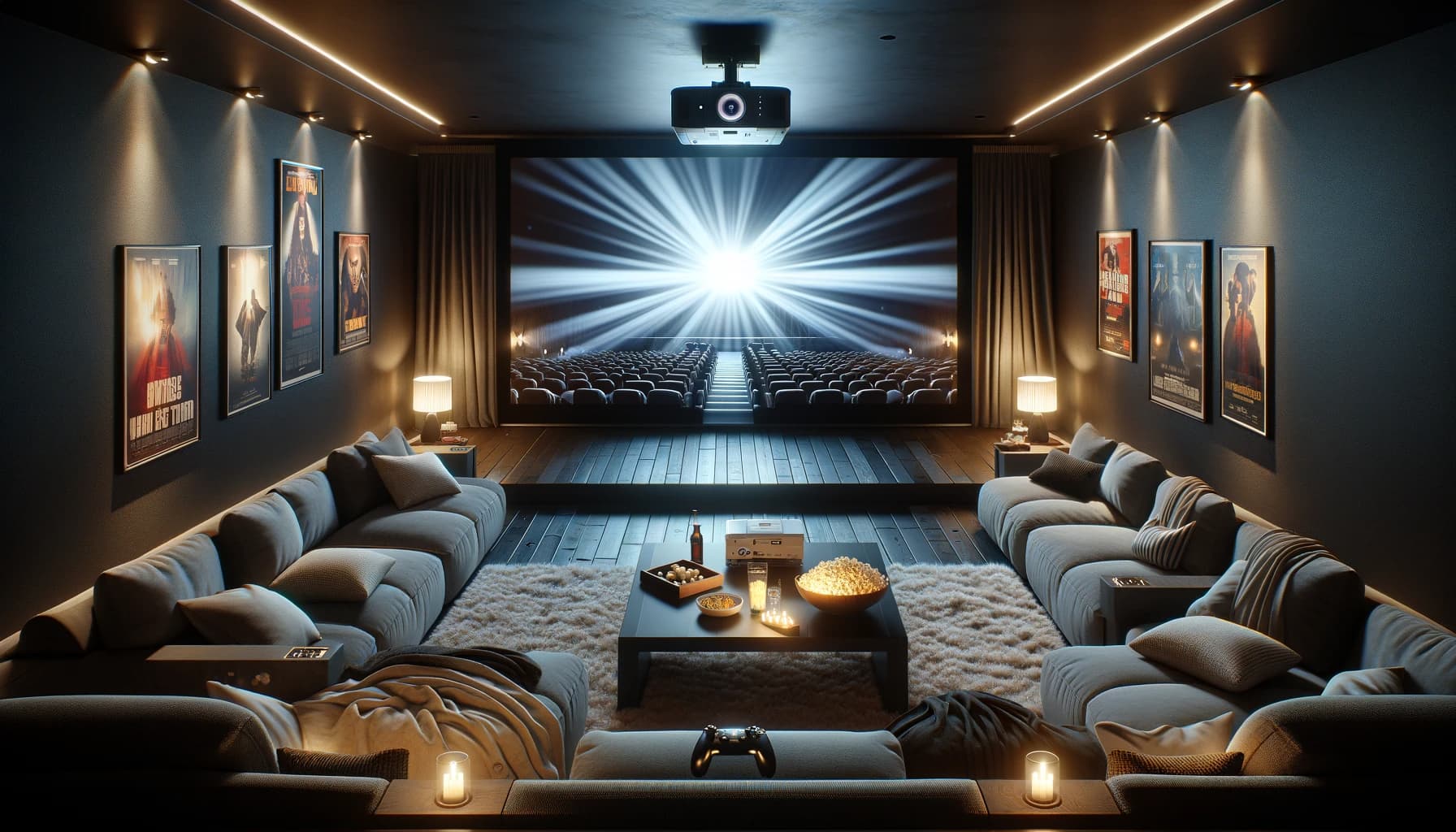Greetings, film enthusiasts! The pursuit of constructing a premium home cinema using digital projectors is not merely an upgrade in your movie-watching routine; it’s an embrace of an extraordinary cinematic adventure right within your abode. Picture a designated area in your residence, crafted for the sole purpose of indulging in cinematic wonders, surrounded by loved ones and friends, all basking in the glory of spellbinding movie sessions.
The cornerstone of this home cinema is the digital projector. This technological gem has the prowess to turn ordinary films into captivating visual feasts, casting them onto expansive screens or walls. Its remarkable ability to generate images that dwarf standard television screens is what brings the essence of a movie theater into the coziness of your home.
However, the path to a sublime home theater transcends beyond merely setting up a projector. It’s a sophisticated craft that involves meticulous consideration of the spatial dynamics of your room, judicious selection of the appropriate apparatus, and harmonizing each component to achieve that quintessential audio-visual synergy.
This detailed guide will escort you through the intricacies of assembling a home cinema using digital projectors. Alongside, we’ll impart essential advice on selecting the finest projector and screen, ensuring you extract the maximum joy from your home cinema experience, in line with the insightful discussions on the gagadget blog.
Budget Analysis for Selecting an Apt Projector
Commencing your projector hunt begins with a realistic assessment of your financial capacity. For those navigating with a limited budget, it’s pivotal to acknowledge that access to high-caliber projectors might be restricted. Under financial constraints, considering a quality television or savoring occasional movie outings could be more feasible.
Conversely, with a budget exceeding $500, you enter a realm where more sophisticated and feature-laden projectors become accessible, greatly enhancing your home viewing experience.
Handpicking the Perfect Projector
The digital projector market is brimming with varied models, each flaunting distinct characteristics. Essential factors to ponder include:
Resolution: The clarity and sharpness of the images hinge on the projector’s resolution. While 1080p and 4K are common, the latter offers superior detail but at an increased cost.
Brightness: Measured in lumens, brightness is crucial for ensuring visibility in different light settings. For enjoying movies with high-quality projectors, especially in dimmer rooms, opt for a projector with a minimum of 1500 lumens. In brighter environments, a 3000 lumens or more projector is advisable for maintaining image quality.
Contrast Ratio: This parameter accentuates the disparity between the darkest and brightest segments of an image. A higher contrast ratio, like 3000:1, guarantees vibrant and dynamic visuals.
Throw Distance: This refers to the distance between the projector and the screen, varying based on room size and preferred image dimensions.
Lens Shift: This feature enables image adjustment without physically moving the projector, aiding in precise alignment with your screen.
For advanced features such as lamp life, noise levels, connectivity, and smart capabilities, the gagadget blog is an invaluable resource for thorough reviews and comparisons.
Selecting a Suitable Screen
The choice of projector screen significantly influences image quality and contrast. Key considerations include:
- Screen Size: Align the screen size with your room’s dimensions and the projector’s capacity;
- Aspect Ratio: Decide between the standard 16:9 or the widescreen 2.35:1, reflecting your preferred viewing format;
- Gain: This measure of light reflection should ideally be around 1.0 or 1.2 to preserve color fidelity and contrast;
- Viewing Angle: Opt for a screen with a broad viewing angle for a consistent quality view across a wider audience.
Setting Up Your Projection Ensemble
Once equipped with your projector and screen, focus shifts to their installation, encompassing:
- Accurate positioning measurements and markings;
- Secure mounting of both screen and projector;
- Linking the projector to power and video sources;
- Adjusting the image for peak quality;
- Conducting tests with diverse content to ensure satisfaction.
Incorporating an Immersive Sound System
A high-quality sound system is crucial for a comprehensive home theater experience. Evaluate factors like channel number, power output, and compatibility with your projector and video sources.
Post-selection, install your audio system by strategically placing speakers and subwoofers, ensuring secure connections. Adjust your audio settings for an enveloping sound experience.
Finishing Touches and Reveling in Your Home Theater
With the setup complete, your home theater is ready for enjoyment. Remember, the right content, controlled lighting, and a cozy ambiance are key to elevating your experience.
Keep refreshments accessible yet safe from the equipment. Most importantly, immerse yourself in the joy of exploring new films and sharing the wonders of your home theater with your dear ones.
In Conclusion
To encapsulate, crafting a home theater with a digital projector is a fulfilling endeavor that significantly elevates your movie-watching experience, transforming it into a cinematic spectacle within the comfort of your home.
It’s about creating a space that resonates with your personal taste and style, where each film becomes an event, a memory, and an adventure experienced like never before.
This journey, while meticulous in its requirement for careful component selection, culminates in a haven for movie enthusiasts, a space where cinematic dreams come to life.

